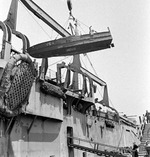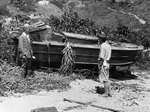Shinyo-class Motor Torpedo Boat
| Country | Japan |
| Displacement | 2 tons standard |
| Length | 20 feet |
| Beam | 5 feet |
| Draft | 2 feet |
| Machinery | One Toyota KC 6-cylinder engine rated at 67hp |
| Speed | 23 knots |
| Crew | 1 |
| Armament | 1x270kg Type 98 explosive charge or 1x300kg explosive charge, optional small arms |
Contributor: C. Peter Chen
This article refers to the entire Shinyo-class; it is not about an individual vessel.
ww2dbaseThe Japanese Navy began working on special attack boats in the spring of 1944. The Navy development program fell under the jurisdiction of the 4th Section (Ship Construction) of the Navy Technical Department at Yokosuka, Japan under the command of Captain S. Makino. The design was kept very simple so they could be built in large numbers. After two prototype forms, six steel prototypes, and two wooden prototypes, the first production example of the Shinyo ("Quaking Sea") Type 1 crash boats was completed on 27 May 1944. Shinyo Type 1 Mod 1 design was released very shortly after, without transmissions to save costs. Unlike most purpose-built special attack weapons, some Shinyo special attack boats were equipped with rocket launchers for additional firepower during the approach. They first saw combat in the Philippine Islands in the fall of 1944. Around the same time, Shinyo Type 5 boats went into parallel construction. Type 5 boats had two engines for greater speed and machine guns for greater firepower; these boats were meant to lead Type 1 boats in attacks.
ww2dbaseThe first Shinyo special attack boats were based in Sasebo, Japan, organized into squadrons each with about 200 men and 48 boats. They were soon dispatched to the Bonin Islands and the Philippine Islands. The first Shinyo mission ended in disaster as one of the boats accidentally detonated, spreading fire to nearby vessels, effectively wiping out one of the Shinyo Squadron 9 units.
ww2dbaseWhen the Iwo Jima, Japan invasion took place in Feb 1945, the Japanese Navy had two Shinyo squadrons on the island, but they were overwhelmed by the pre-invasion bombardment and they were generally ineffective. At Kerama Retto in the Ryukyu Islands southwest of Okinawa, the Shinyo boats under the command of the 5th Sea Raiding Base Headquarters were also ineffective; in fact, most of the 250 boats deployed there were scuttled by their own crew as they could not get the opportunity to launch missions. On Okinawa, both Navy and Army special attack boats got their chances to attack, sinking landing ship LSM-12 on 31 Mar 1945 and gunboat LCI(G)-72 on 3 Apr; nevertheless, far more Shinyo and Renraku-tei boats were destroyed than the number that got through American picket lines.
ww2dbaseThe Japanese Navy had planned to build 7,000 Shinyo special attack boats by Sep 1945; when the war ended, 6,200 were actually built. At the end of the war, 1,249 boats were deployed in the Japanese home islands, while an additional 900 were kept in reserve.
ww2dbaseSource: Steven Zaloga, Kamikaze: Japanese Special Attack Weapons 1944-45
Last Major Revision: Sep 2011
Shinyo-class Motor Torpedo Boat Interactive Map
Photographs
 |  |  |  |
Shinyo-class Motor Torpedo Boat Operational Timeline
| 27 May 1944 | The first Shinyo special attack boats were completed. |
| 31 Jan 1945 | American submarine chaser PC-1129 intercepted Japanese Shinyo special attack boats in the Philippine Islands, but she was in turn rammed by one of the boats and was sunk. |
| 15 Feb 1945 | Japanese Shinyo explosive motor-boats sank three American LCS(L) armoured support craft at Mariveles Harbour, Bataan, Philippine Islands. |
| 29 Mar 1945 | Japanese Navy Shinyo special attack boats launched an attack at Okinawa, Japan to no effect. |
| 3 Apr 1945 | Special attack boats of Japanese Navy Shinyo Squadron 22 sank American gunboat LCI(G)-82 at Okinawa, Japan. |
| 9 Apr 1945 | The Japanese Navy scored a notable success against the Americans when a large Shinyo Motor Boat packed with explosives charged out of Naha harbour, Okinawa, Japan to ram the USS Charles J. Badger putting the destroyer out of the war with both engines utterly unserviceable. A landing-craft was sunk on the same night and, from the fringes of the destroyer screen, came a report of swimmers armed with hand-grenades, although whether these were, in fact, Fukuryu ("Crawling Dragons") suicide-frogmen still remained uncertain. |
| 27 Apr 1945 | Japanese Shinyo special attack boats damaged destroyer USS Hutchins and an LCI landing ship at Okinawa, Japan. |
Did you enjoy this article or find this article helpful? If so, please consider supporting us on Patreon. Even $1 per month will go a long way! Thank you. Share this article with your friends: Stay updated with WW2DB: |
» Planned and Actual Tokko Naval Weapon Production, 1945-1946
Related Books:
» Kamikaze: Japanese Special Attack Weapons 1944-45
 |
- » 1,150 biographies
- » 337 events
- » 43,917 timeline entries
- » 1,241 ships
- » 350 aircraft models
- » 207 vehicle models
- » 375 weapon models
- » 123 historical documents
- » 260 facilities
- » 470 book reviews
- » 28,545 photos
- » 432 maps
Chiang Kaishek, 31 Jul 1937
Please consider supporting us on Patreon. Even $1 a month will go a long way. Thank you!
Or, please support us by purchasing some WW2DB merchandise at TeeSpring, Thank you!